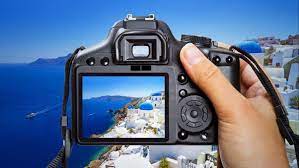
Digital photography refers to the process of capturing images using a digital camera or other devices equipped with image sensors. Unlike traditional film photography, where images are recorded on light-sensitive film, digital photography captures light and converts it into digital information that can be stored, manipulated, and reproduced electronically.
Evolution of Digital Photography
Emergence of Digital Cameras: The first digital camera was invented in the early 1970s, but it wasn't until the 1990s that consumer-grade digital cameras started gaining popularity. These early cameras had limited resolution and storage capabilities, making them less appealing than film cameras. However, as technology advanced, digital cameras became more accessible, affordable, and user-friendly.
Rise of Smartphones: The integration of cameras into mobile phones revolutionized digital photography. With the widespread adoption of smartphones, virtually everyone had a camera in their pocket, enabling easy and instant image capture. The continuous improvement of smartphone camera technology has made them capable of producing high-quality images comparable to dedicated digital cameras.
Advancements in Image Sensors: Image sensors play a vital role in digital photography. Over the years, sensor technology has greatly improved, resulting in higher resolution, improved low-light performance, and better color reproduction. The introduction of larger sensors, such as APS-C and full-frame, has further enhanced the capabilities of digital cameras, appealing to professional photographers.
Advantages of Digital Photography
Instant Feedback: One of the significant advantages of digital photography is the ability to preview images immediately after capture. This instant feedback allows photographers to make adjustments to composition, exposure, and other settings, resulting in better shots. It also enables quick identification and deletion of unwanted images, saving time and storage space.
Post-processing and Editing: Digital photography offers extensive post-processing possibilities. With the help of photo editing software, photographers can enhance and manipulate their images. Adjusting exposure, contrast, colors, and removing imperfections are just a few examples of the creative control digital tools provide. Additionally, the ability to shoot in RAW format allows for non-destructive editing and maximum flexibility.
Cost and Convenience: The cost-saving aspect of digital photography is undeniable. Unlike film photography, there are no expenses associated with purchasing and developing film rolls. The convenience of digital storage eliminates the need for physical albums or negatives, as images can be stored, organized, and easily accessed on various devices or cloud platforms.
Sharing and Connectivity: Digital photography has facilitated seamless sharing and connectivity. Social media platforms, photo-sharing websites, and online galleries have made it effortless to showcase and distribute photographs globally. The ability to instantly share images with friends, family, or a wider audience has transformed the way we communicate and express ourselves visually.
With the rise of social media and the increasing demand for visual content, digital photography has become a lucrative business opportunity. In Nigeria, where the creative industry is thriving, starting a digital photography business can be a rewarding venture. However, like any entrepreneurial endeavor, it requires careful planning and execution.
In this article, we will outline eight essential steps to help you embark on your journey to establish a successful digital photography business in Nigeria.
Step 1: Define Your Niche
Before diving into the photography business, it is crucial to identify your niche. Determine the specific genre or style of photography you want to specialize in, such as wedding photography, fashion photography, product photography, or wildlife photography. This will help you target the right audience and develop a unique selling point for your business.
Step 2: Acquire the Necessary Skills and Equipment
Investing in the right equipment and acquiring the necessary skills is vital for a digital photography business. Attend workshops, enroll in photography courses, or undertake online tutorials to enhance your technical knowledge and artistic abilities. Additionally, ensure that you have a professional-grade camera, lenses, lighting equipment, and editing software to deliver high-quality photographs.
Step 3: Develop a Portfolio
Building a portfolio is crucial for showcasing your skills and attracting potential clients. Start by offering your services to friends, family, and local businesses at discounted rates or even for free to gather a diverse collection of photographs. Create an impressive online portfolio or a physical portfolio book that exhibits your best work, demonstrating your expertise and style.
Step 4: Establish Your Brand
Create a strong brand identity that reflects your style and values. Choose a business name that is memorable and relevant to your photography niche. Design a logo, website, and social media profiles that align with your brand. Consistency across all platforms will help build trust and recognition among your target audience.
Step 5: Set Up Your Business
Register your business with the appropriate government agencies, such as the Corporate Affairs Commission (CAC) in Nigeria. Determine your business structure (sole proprietorship, partnership, or limited liability company) and obtain the necessary permits and licenses required to operate legally.
Additionally, consider setting up a separate bank account for your business finances.
Step 6: Pricing and Packaging
Determine your pricing structure based on factors such as your experience, market demand, and the cost of running your business. Research the rates charged by other photographers in your niche to ensure your prices are competitive. Create different packages tailored to the needs of your clients, offering a range of services and pricing options to accommodate various budgets.
Step 7: Market Your Services
Develop a comprehensive marketing strategy to reach your target audience effectively. Utilize online platforms such as social media (Instagram, Facebook, Twitter) and professional networking sites (LinkedIn) to showcase your work and engage with potential clients. Collaborate with other professionals in the industry, participate in photography exhibitions, and leverage word-of-mouth referrals to expand your client base.
Step 8: Provide Exceptional Customer Service
Delivering exceptional customer service is crucial for establishing a reputable photography business. Communicate promptly and professionally with clients, understanding their requirements and preferences. Deliver high-quality photographs within the agreed-upon timeframe and provide post-production services, such as editing and retouching, to ensure client satisfaction. Encourage clients to provide feedback and testimonials, which can further enhance your business reputation.
In conclusion, starting a digital photography business in Nigeria can be a fulfilling and profitable venture. By following these eight essential steps, you can lay a solid foundation for your business.
Remember to continually improve your skills, stay updated with industry trends, and adapt to the evolving needs of your clients. With dedication, creativity, and excellent customer service, your digital photography business can thrive in the dynamic Nigerian market.






















